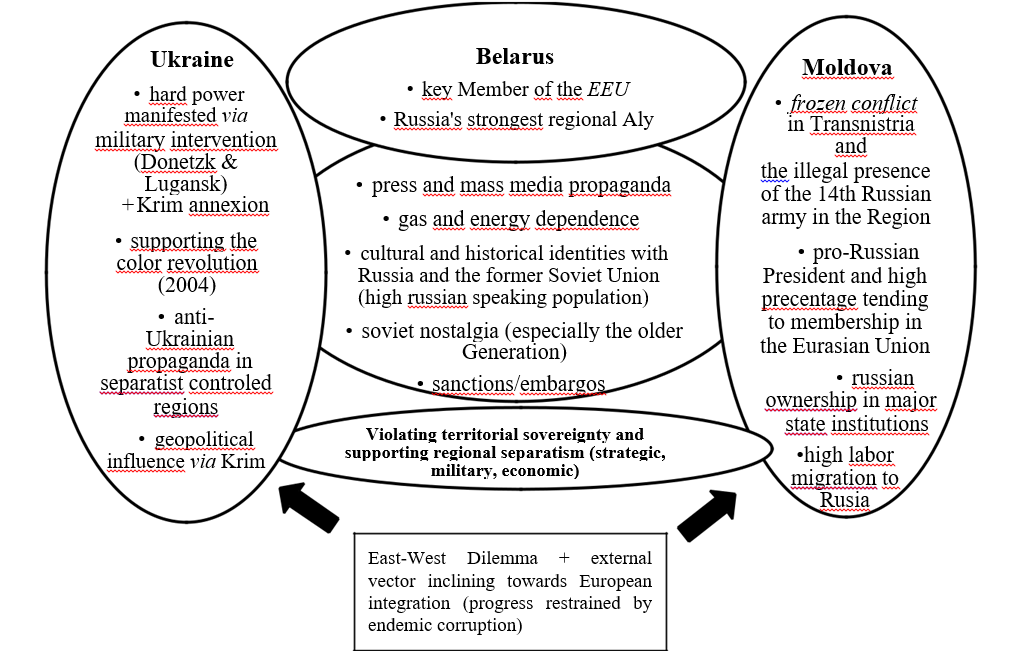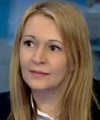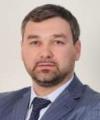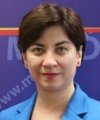
Roman Șarov
Introduction
Russia’s foreign policy commitments and the inclusive Status Quo in the Eurasian space are strongly interconnected by means of its common historical heritage, cultural space and the parallel participation in various supranational organizations as the Commonwealth of Independent States (CIS) and the Eurasian Economic Union (EAEU). The functioning of these organizations are fundamental for the distribution and manifestation of Russia’s foreign interests on a multidimensional level. Especially in regard to the EAEU, which evolved as a counterbalance to the European Union, is Russia seizing to establish via diverse political mechanisms an exhibition of its great power identity. The enlargement of the organization caused a rift in the regional order on the divergence of either European integration or Eurasian integration. A practical case in point is the Armenian transit from the European integration pathway to a fully-fledged member of the EAEU. Despite the sheer variety behind post-Soviet countries’ motivations for enhancing relations with the EU, the US and NATO, as well as different degrees of integration sought with Western structures, regarded Russia these attempts at closer links with the West overall as a threat to its interests in the post-Soviet space. However, its response varied depending upon the perceived loyalty of the post-Soviet states to Russia. For instance, between 2004 and 2008, as a consequence of Georgia’s pro-European aspirations, used Russia the manifold ties inherited from the Soviet era to scale up pressure on the Georgian authorities, with the political objective to hinder further integration with Western structures (Delcour, Wolczuk 2015). Russia’s foreign policy agenda has had some major highlights along the years; a milestone was Putin’s Munich press conference (2007)1, which altered the tone vis-a-vis Russia’s growing role in world affairs, as Russia’s implications indeed intensified only one year later with the onset of the Georgian war (2008) and afterwards the Ukraine Crisis (2013-present). The following thesis will examine Russia’s foreign policy framework during the past eighteen years, in connection with its most efficient foreign policy mechanisms- applying hard power via soft power and therefore boycotting hybrid states from advancing on the pathway to democratization and modernization and resulting in the consolidation of regimes of instability. Additionally, a comparison between the Eastern Partnership (EaP) States: Moldova, Belarus and Ukraine, aims to point out the parallels and alterations of Russia’s modern-day foreign policy mechanisms. Concluding, reveals this the inflicting Russian external vector – the realization of a unipolar regional order and foremost the reinforcement of a Russian great power identity in the Eurasian space.
2. Russia’s foreign policy agenda (2000 – 2018)
The state of affairs in the Russian foreign policy shifted indefinitely with Vladimir Putin’s election as Russia’s president in 2000 and marked a new era in Russia’s external vector. After the chaos and hardship of the 1990s, the new president managed to stabilize the country and restore economic growth. This was later manifested in Russia’s relative rise in world politics and a more assertive policy to defending Russia’s interests abroad. Moreover, started the Russian government decelerating its economic dependence and undermined many Western interests. The economic stabilization of the nation state (after the two brutal Chechnya Wars) correlated with the manifestation of Russia’s increasing anti-Western rhetoric and its rising interests in extending its regional great power identity to the upmost level- Eurasian hegemony.2 In order to attain a comprehensive understanding of the genuine circumstances and as to why Russia is striving to achieve hegemony in the Eurasian space, a psychological perspective should be incorporated in the analysis. Vis-à-vis its further expansion is the desire for status particularly acute for Russia’s foreign policy aspirations, which suffered a catastrophic decline in its position with the eradication of the Soviet Union and has viewed itself as a great power for centuries. Consistent with psychological research and theory, responded Russia emotionally to perceived humiliation. The Russian takeover of Crimea and the 2014 Ukrainian crisis illustrate the risk that continued Russian bitterness over its loss of great power status, which could lead to a return of geopolitical competition. The literature on identity, status and emotions suggests that isolation and exclusion of emerging great powers will evoke anger, vengefulness and competition to supplant the dominant powers and will enhance further conflicts.3 In this regard, have several political affairs to be taken into consideration: the appearance of the ENP in the regional order, the further expansion of the NATO, the military advancement of the Conflicts in Georgia, Ukraine and the annexation of the Crimean peninsula have altogether altered Russia’s outlook on its foreign policy agenda and accentuated the crucial role of its soft power mechanisms indefinitely. Russia’s course of action especially towards its Eastern European and South Caucasian neighbors was (re-)contextualized within the broader picture of a more assertive Russia in the international arena in connection with impressive economic growth resulting from a surge in oil prices. In this way, a unique structure to impinge on the ‘disloyal’ countries had been created.4
3. Enforcing hard power via soft power mechanisms
The appearance of the soft power concept in the Russian foreign policy landscape is a relative modern one, which at first did not have much tangency with Russia’s outlook. As in tsarist Russia and later in the Soviet Union, power tended to be unilaterally defined as “hard power”, their policies were highly focused on military power while internally the authorities often resorted to brutal violence and police repression. Joseph S. Nye first brought the term to life in 1990, in his theoretical explanation is soft power emanating from both civil society and the state – in Russia’s case, it was reduced to a simple instrument used by the state to influence governments and manipulate foreign public opinion.5 However, a real interest in the phenomenon occurred only after the “color revolutions”6 in the post-Soviet space: the 2003 Rose Revolution in Georgia and the 2004 Orange Revolution in Ukraine.7 At this point, the Kremlin woke up to a new reality, that its dominance is not sole depending on its military power, but also on evolving factors as the internet and social media, which became an important strategic asset for its targeted foreign policy objectives and benefiting therefore from strategic soft power to enhance its military hard power.
Strategic operated soft power mechanisms provide legitimacy for hard power interventions and are directly linked to Russia’s military presence, for instance in the unrecognized provinces of Transnistria, South Ossetia, Abkhazia, Nagorno-Karabakh and in the ongoing disputes in Donetsk and Lugansk. These disputes are representative for the hard power via soft power hypothesis, as they combine illegal “peacekeeping operations” with a direct violation of the country’s territorial integrity. Actions as such are backed up by a deep enrooted system of press and mass media propaganda. Despite the rise of the internet as an alternative source of political information among the younger generations, believe 88% of residents in the Eastern neighborhood countries that TV forms public opinion (Ecorys Survey Report 2016: 28). In this way efforts to spread specific ideological narratives can strengthen interventionist linkages.
Explicitly, here are three major elements of soft power mechanisms emphasized, which are intended to destabilize and enforce Russian and Soviet nomenclature:
1) The Russian Orthodox Church (ROC)
A recent empirical survey has shown that there is a link between the self-identification as a member to the Orthodox Church and support for Russia’s role in the world as a ‘counterweight’ to the West in Central and Eastern Europe (Pew Research Center 2017). The Church’s foreign policy objectives are multi-pronged and diverse, yet they share many similarities with the government of Russia’s foreign policy priorities. As In 2009, the ROC and United Russia (Единая Россия) expressed their intent to “jointly decide what their common values are and what modernization tasks must be accomplished” in the context of Russia’s development plans. Resulting in the Church to play an instrumental role in shaping Russia’s national development priorities, and as a natural extension of this, influencing the national security policy and threat perception as well.8
2) Press and Mass media
This soft power instrument is particularly controversial, as in most cases, it creates a conflict of interests between the national (state owned) mass media and the Russian state sponsored propaganda. An interesting comparison can be found in the study- Russia and the EU in the (National) News: A Three-Country Comparison9. For instance, in both Belarus and Moldova Russian TV channels are cited as the main source for news and current affairs programs by 37% of respondents in Belarus and 38% in Moldova (Annual Survey Report: Regional Overview- Eastern Partnership Countries 2016). In Ukraine, local versions of various Russian news outlets have been banned since 2014. Therefore, can the press be regarded as a strong foreign policy mechanism, as it does not only involve the Russian speaking community, but also has a destructive effect on other actors, as the European Union.10 (Potapova, 2017)
On the other side is the ideological influence, in Kazakhstan for instance characterized by other elements, where official mass media is broadly promoting ideas of Eurasianism and the benefits of the EAEU integration.11
3) Migration and Sanctions
A new understanding of labor migration came at the beginning of the 21st century, when an improving Russian economy led to increased demand for labor, especially in construction, transport, and services. Workers of former Soviet republics that were not faring as well economically (except for Kazakhstan) were drawn to Russia in search of higher salaries and the aspiration to provide a better life for their families back home.12 The entry of thousands of temporary migrant workers each year (one emblematic example is Tajikistan, which is one of the world’s most remittance-dependent countries, each year, an estimated million Tajik citizens, mostly men, travel abroad in search of work)13 offers Russia a great deal of flexibility in terms of foreign policy maneuvering. Case in point: the highly efficient practice of “passportization” (Nagashima, 2017) thereby encouraging citizens of other post-Soviet countries, in particular originating from the unrecognized Republics: Abkhazia, South Ossetia, and Transnistria to apply for Russian passports. This way were interventions in other countries framed, as the protection of Russian citizens abroad is a key pillar of its modern foreign policy. (Kiseleva, 2015)
4) Foreign policy vis-à-vis Moldova, Belarus and Ukraine
The comparative analysis of the following three Eastern Partnership (EaP) countries aims to emphasize the different type of conduct and soft power mechanisms implemented by Russia since 2000. Beforehand, should be stressed out that all three EaP member states, especially due to their strategic geographical positioning, bordering on the European neighborhood are regarded as key objectives to Russian foreign policy interventions. Therefore, does the Russian foreign policy manifest a high interest in continuously interfering with different purposes and tools in these states since the 2000th. The state of affairs in the assessed countries are emblematic, due to the similar mechanisms being applied (economic sanctions, supporting separatism movements and energy & gas dependency), but have occurred under different scenarios and consequences. The major Russian foreign policy instruments in the region remain military support and energy transit management.
– Key foreign policy tools towards Belarus: gas & energy dependency and commercial embargos
To begin with, should be mentioned that Belarus, with its internal and external vector is strongly regarded as pro-Russian and also represents a key member of the EAEU and therefore only holds limited cooperation agreements with the European Union.14 Although considered the strongest and most devoted regional ally, disparities have particularly occurred in the aftermath on issues regarding energy, oil and embargos.15 Although Belarus is closely institutionally connected with Russia, attempt’s Lukashenko regime also an expansion on the relationships with the West. In addition, the capital of Belarus (Minsk) hosted the Ukrainian peace process negotiations and Belarus also not backed Russia’s military interventions neither in Crimea, nor in eastern Ukraine and has resisted fierce pressure for several years to host a Russian air base on its territory.16
– Key foreign policy tools towards Moldova: migration workers, financing separatism in Transnistria, press and mass media propaganda
The Status quo concerning Moldova is from a Russian foreign policy perspective vital, as the country borders with both Romania and Ukraine and therefore represents a geopolitical stronghold. More than that, is direct hard power through the illegitimate “peacekeeping operation” in the unrecognized, separatist Region of Transnistria being applied. In Moldova, which for some time has been regarded the success story17 of the EaP and with the signing of the Association Agreement (AA) and the Deep and Comprehensive Free Trade Area (DCFTA), has made some major steps forward on the pathway of European integration. Even though remarkable achievements were registered in the economic and political ties with the EU, the major issue-corruption is not being fought enough. Benefiting from the country’s political turbulence and instability are further revelations that Moldova was a major link in a money-laundering scheme that originated in Russia and reportedly laundered as much as $20 billion (possibly even more) between 2010 and 2014. The country’s external vector is constantly varying on the Est-West dilemma and the current geopolitical situation with Transnistria as a buffer zone. (Karaganov, 2016)
– Key foreign policy tools towards Ukraine:
The case of Ukraine is the most prominent regarding a Russian implication via hard power, as of today the Ukrainian authorities are on the verge of passing a new law, which will adjust the official status of the conflict from a “anti-terrorist operation” to a mission to send armed forces against “military formations of the Russian Federation” in Donbass.18 Furthermore, while up until now the self-declared republics of Donetsk and Lugansk were considered under the Minsk Accords as negotiating parties, now there are only “occupation administrations” of the Russian Federation on these territories, with Russia identified as an “aggressor”. Furthermore, the “classic” soft power tools are being likewise enforced in the Ukraine: a high oil and energy dependency, but also modern-day tools as cyberwarfare19. As to how interconnected the states and their issues are can be observed in a new investigation20, wherein Moldovan mercenaries (mainly from Transnistria and biased by pro-Russian propaganda) are attracted to join the hostilities in the Donbas region (financed by Russian forces). Such profound establishment of propaganda displays the interconnection between hard power and soft power mechanisms.
The following graph aims to emphasize Russia’s foreign policy mechanisms applied in the three EaP States in regard to nation state specifics and common features:

These Manifestation of both hard and soft power mechanisms highlight that domestic gatekeepers can to some extent prevent (as in the case of Ukraine), moderate, or enhance the influence of the Russian actors.21This comparative analysis between the different foreign policies tools used in the three countries reveals not only the instituted establishment of hard power tools, but also the antagonism in the external vector in Ukraine and Moldova. Moldova’s case has been the subject of much attention as the presidential electoral campaign led to the election of an openly pro-Russian president who moved to request observer status in the EAEU. In addition, the upward trend for soft power tools continues as Russian “alternative narratives” about the recent past and current geopolitical relations are reinforced by propaganda in the news (Wilson, 2017), also innovative tools as cyberwarfare or attracting by the use of pro-Russian propaganda Moldovan mercenaries to join the separatist Regimes in Donetsk und Lugansk.
5. (Re-)enforcing Russian great power identity
Interconnecting Russia’s foreign policy interests since 2000 and its manifestation of both hard and soft power in the regional order have mutually targeted attaining a greater power identity and a hegemonic strength in the Eurasian space. Russia’s enforcement in the Eurasian space has been the subject of many theories. (Samokhvalov, 2017), (Entin, Entina, 2016) Particularly in regard to reestablishing its legacy in the region is Aleksandar Dugin’s outlook controversial. He gives the most radical theory22 in regard to Russia’s hegemonic outlook in Eurasia, as he distinguishes four central civilizational zones: the American, the Afro-European, Asian-Pacific and lastly the Eurasian. The Eurasian order is distinguished by a Russian hegemony on the axis Russia-Germany-Japan-Iran alliance. The influence of “Duginism” has become even more prominent during Putin’s third presidency, as the creation of the Eurasian Union became Russia’s main foreign policy goal and offers an institutional arrangement of reinforcing its regional authority.23 Amid Russia’s recent territorial moves, primarily aimed to bring about with hard power the type of buffer zone that diplomacy and soft power previously failed to deliver, the revival of an old term came to justify it: Novorossiya, (‘New Russia’). Such a view is commensurate with the positions of a sizeable number of Russia’s foreign policy specialists who subscribe to the school of neo-Eurasianism, or ‘geopolitics’.[1]
Applying the cause and effect formula can point towards Russia’s main aspirations in connection with (re-)enforcing its great power identity: firstly, maintaining an overall dependency in the hybrid states via a multiplicity of soft power tools (migration, energy/gas or imposing embargos on imported products). As a chain reaction, this leads to acute economical & social dilemmas in the hybrid states and therefore produces a suitable climate of instability and therefore maintaining regional influence. Then again, for an in-depth understanding of Russia’s power bargaining it is crucial to take into examination the antagonist Actor – the EU. The creation of the EAEU and the European Neighbourhood Policy as such emphasize the manifestation of a bipolar, (geo-)political power play going on between the EU and Russia, as they target many of the same states for incorporation into future expanded economic and political collaboration. This aspect is especially crucial, as in most cases, it has a significant repercussion not only on the regional order, but also on the overall Status Quo of the former Soviet States.[2]
Another key aspect of a comprehensive understanding of Russia’s impulses on attaining a greater power identity is the contested states of the European Neighbourhood Policy. The EU’s and Russia’s approaches to their common neighbourhood have often been contrasted as opposites, with the EU frequently portrayed as a prime supporter of democratization in the former Soviet space and Russia frequently presented as a spoiler of democratization, if not an outright supporter of authoritarianism in the region. Both external actors have used a wide variety of instruments ranging from more coercive to softer tools to influence the domestic political trajectories of the former Soviet states, geographically squeezed between the EU and Russia. The democracy ratings of the countries concerned indicate that the authoritarian temptation has been strong across the region, but that democracy has nevertheless found more conducive ground in some countries than in others. (Smith, 2016) The Eurasian Economic Union is in this sense the institutional vehicle through which common regulatory and governance space across the participating post-Soviet countries is established, mimicking the EU’s own experiment and engaging in what some have called “normative rivalry” with the EU in the “shared neighbourhood”. (Noutcheva 2018) The political discourse post Putin’s 2007 Munich speech changed dramatically. As Medvedev (at that time president of Russia) in the 2009 annual address to the Federal Assembly of the Russian Federation claimed that: “The foundation of my vision for the future is the firm conviction that Russia can and must become a global power on a complete new basis” (Medvedev, 2009). Such discourse represents a transposition in Russia’s acceptance of the unipolar system and signals that the relations of the country with the west will degrade. Moreover, it is a clear sign that Russia’s adoption of a more assertive foreign policy is translated into practice by a more bold, strong attitude, in which Russia renounced to the idea of proving that it is a great power and started acting as one (Rotaru, 2014). Social aspects as labor migration are as well a vital factor in the Russian great power narrative (in the CIS, area is the flux estimated at 9–10 million people a year). The main donor countries are Armenia, Azerbaijan, Belarus, Georgia, Kyrgyzstan, Moldova, Tajikistan, Ukraine and Uzbekistan. Almost 70% of all migrant workers go to Russia. Labor migrant remittances make up close to half of GDP in Tajikistan and 31−32% of GDP in neighboring Kyrgyzstan. These two countries are the most remittance-dependent in the world.24
6. Summary
The preceding analysis concentrated foremost on examining Russia’s foreign policy framework during the previous eighteen years, in connection with its highly efficient foreign policy mechanisms – applying hard power via soft power. By the use of a three State comparison (Belarus, Moldova and Ukraine), were the linkages, but also the alterations of Russia’s modern-day foreign policy mechanisms in each case examined. This way could several common patterns be identified: labor migration, press and mass media propaganda or the interconnection between an affiliation to the Orthodox Church and support for Russia’s role in the world. In addition, should be stressed out that the impact of innovative soft power mechanisms is progressively increasing, as per financing separatism or the growing influence of cyberwarfare on both a regional and international scale. Enforcing hard power as such is difficult and illegitimate, as it violates territorial sovereignty and contravenes with international law. In this sense is by way of soft power legitimacy being given to military intervention and radical foreign policy vectors. A deep-rooted paradigm for spreading foreign policy impulses is the press and mass media propaganda, which plays an essential role in (re-)enforcing its intentions in the soviet hybrid states. As the three-state comparison points out, are especially in Moldova and Ukraine (both tend towards a European integration pathway) the applied multidimensional hard and soft power mechanisms particularly aggressive, as they mostly contravene with the interests of the European Union in the space. Furthermore, the outlook in regard to a decrease of a Russian hegemony is discouraging, as by the use of illegitimate “peacekeeping operations” and control over the frozen conflicts another way of maintaining a climate of instability and preventing the country from developing is preserved. The influence of Russia’s foreign policy interventions is likewise reflected via the Eurasian Economic Union, which is an extended platform for enhancing its great power identity in the Eurasian space. The contemporary linkages with the states of the wider Eurasian region is primarily motivated by the cultural and historical associations with Russia and the former Soviet Union. Concluding, does the modern-day Russian foreign policy reveal the arrangement of a suitable platform (perceiving the entire post-Soviet space as a homogenous sphere of influence) for attaining a unipolar regional order and foremost – reinforcing a Russian great power identity in the Eurasian space. The manifesto of great power identity is an effect of the multidimensional hard and soft power mechanisms applied, which are not exclusively limited by military interventions, but are deep rooted in the societies of the Eurasian space and based on religious, cultural, spiritual and soviet linkages.
[1] (Kubyshkin, Aleksandr Sergunin 2012)
[2] (Sussex, Kanet 2015)
[1] Putin’s statement: I would allow myself to make one small remark. It is hardly necessary to incite us to do so (that Russia should play an increasingly active role in world affairs). Russia is a country with a history that spans more than a thousand years and has practically always used the privilege to carry out an independent foreign policy. We are not going to change this tradition today.
[2] Antonovič, Marijuš: „To What Extent has Russia’s Foreign Policy since 2000 been influenced by Eurasianism? Lithuanian Foreign Policy Review 30 (2013): 11-42.
[3] Larson Deborah Welch; Shevchenko, Alexei: Russia says no: Power, status, and emotions in foreign policy. Communist And Post-Communist Studies 47, no. 3-4 (2014): 269-79.
[4] Delcour, Laure: The EU and Russia in Their ‘contested neigbourhood’. Multiple external influences, policy transfer and domestic change, (2017).
[5] Nye, Joseph (1990): <em>Bound to Lead: The Changing Nature of American Power\ / New York, Basic Books (1990).
[6] popular movements which swept away corrupt and undemocratic regimes
[7] Van Herpen, Marcel H.: Putin’s Propaganda Machine. Soft power and Russian foreign policy, (2016): 20-30
[8] Blitt, Robert C.: Russia’s „Orthodox” foreign policy: the growing influence of the Russian orthodox church inshaping Russia’s policies abroad, (2011): 364–380.
[9] which highlights the growing area of analysis concerning the spread of fake news and propaganda originating from Russia and targeting the EU member states or the Eastern Partnership countries EU-STRAT-Working-Paper-No-4.pdf
[10] the main narratives about the EU depict it as an aggressive and expansionist enemy, as a weak union that cannot deal with global challenges, and as a union lacking moral values.
[11] Likhachev, Maksim Russia’s image in the mass media of Kazakhstan, (2015). Available online at https://en.riss.ru/analysis/18738/.
[12] Chudinovskikh, Olga; Denisenko, Mikhail: a Migration System with Soviet Root, (2017). Available online at: https://www.migrationpolicy.org/article/russia-migration-system-soviet-roots.
[13] Putz, Catherine: The Feminized Farm: Labor Migration and Women’s Roles in Tajikistan’s Rural Communities.As Tajik men go abroad in search of higher pay, women take on increased roles in Tajikistan’s agriculture sector, (2018). Available online at https://thediplomat.com/2018/01/the-feminized-farm-labor-migration-and-womens-roles-in-tajikistans-rural-communities/.
[14] Rice-Oxley: Belarus: 20 years under dictatorship and a revolution behind the rest of Europe, (2014). Available online at https://www.theguardian.com/world/2014/jun/09/-sp-belarus-remains-revolution-behind.
[15] Barry, Elen: ‘Milk War’ Strains Russia-Belarus Ties, The New York Times, (2009). Available online at: http://www.nytimes.com/2009/06/15/world/europe/15belarus.html.
[16] Wilson, Andrew: <em>Is Russia Practicing a Dry Run for an Invasion of Belarus? (2017). Available online at: http://foreignpolicy.com/2017/09/18/is-russia-practicing-a-dry-run-for-an-invasion-of-belarus/.
[17] Vlas, Cristi: Moldova-EU’s failed “success story”, (2015). Available online at: http://www.moldova.org/en/moldova-eus-failed-success-story/.
[18] Doctorow, Gilbert: A Coming Russia-Ukraine War? (2018). Available online at: https://consortiumnews.com/2018/01/21/a-coming-russia-ukraine-war/.
[19] Sions, Arthur W.: Cyber conflict: The Ukrainian practice field (Order No. 10686924), (2017). Available from ProQuest Dissertations; Theses Global. Retrieved from: https://search.proquest.com/docview/1978484306?accountid=11004.
[20] Livadari, Alina: Moldovan mercenaries in the Donbass region: “It takes me five seconds to kill a man”// RISE, (2018). Available online at http://www.moldova.org/en/moldovan-mercenaries-donbass-region-takes-five-seconds-kill-man-rise/.
[21] EU-STRAT Working Paper Series No. 04: <em>the Elements of Russia’s Soft Power: Channels, Tools, and Actor.
Promoting Russian Influence in the Eastern Partnership Countries, (2017).
[22] Dughin, Aleksandr : Evraziystvo ot filosofii k politike: Doklad na Uchreditelno sezde OPOD ‘Evrazii’, Moskva (Moscow), (2001).
[23] Van Herpen, Marcel H.: Putin’s Propaganda Machine. Soft power and Russian foreign policy, (2016): 188-193.
[24] Molchanov, Mikhail: Eurasian Regionalism: Ideas and Practices, (2015): 135-160.

















Lasă un răspuns
Trebuie să fii autentificat pentru a publica un comentariu.